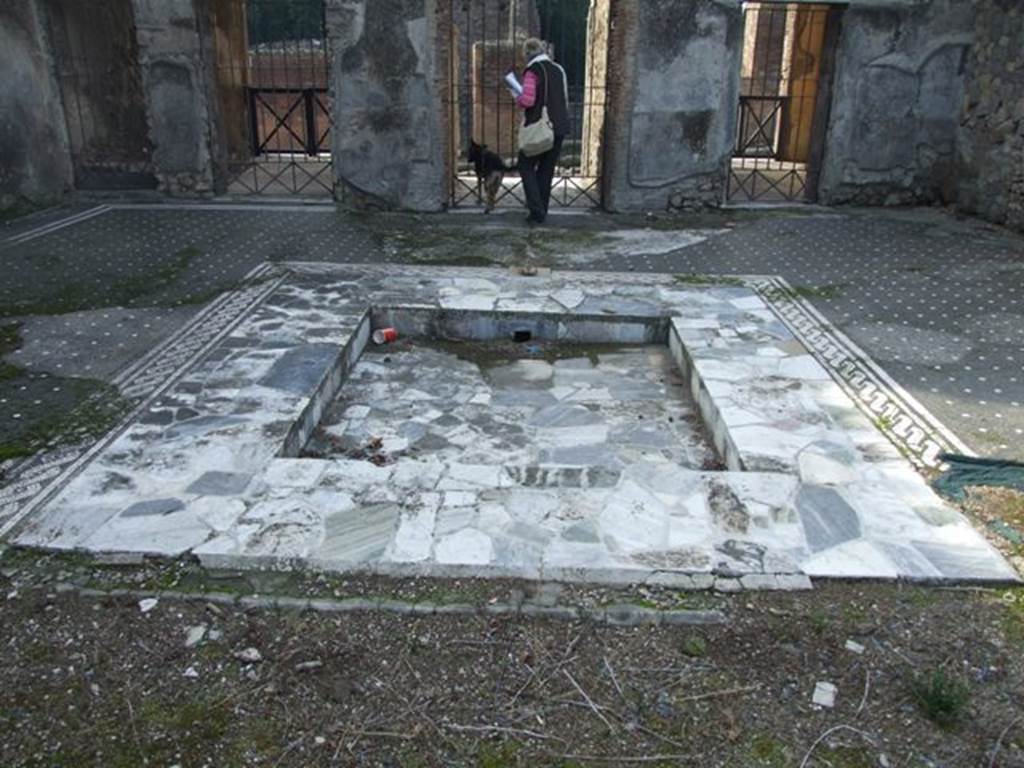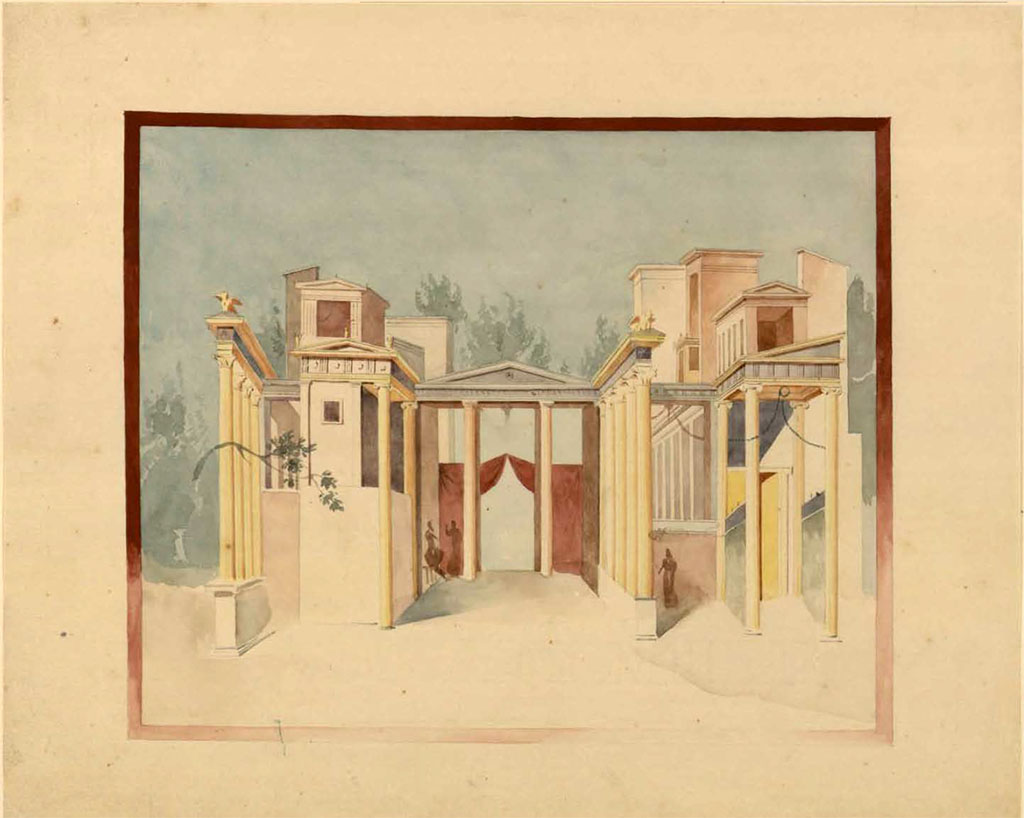VI.1.7 Pompeii. House of
the Vestals or Casa delle Vestali.
Linked to VI.1.6,
VI.1.8, VI.1.24, VI.1.25 and VI.1.26.
Part 7 Part 1 Part 2
Part 3 Part 4 Part 5
Part 6 Plan

VI.1.7 Pompeii. December 2007. Room 35, looking west.

VI.1.7 Pompeii. December 2007. Room 35, south wall.

VI.1.7 Pompeii. December 2007. Room 35, area in south-west corner.

VI.1.7 Pompeii. December 2007. Room 35, looking south in south-west corner.

VI.1.7 Pompeii. December 2007. Room 35, looking east.

VI.1.7 Pompeii. December 2007. Room 36, looking west.

VI.1.7 Pompeii. Looking across atrium towards entrance. Photograph May 2001 courtesy of Current Archaeology.

VI.1.7 Pompeii. December 2007. Looking north from room 36, into the doorway of room 37.

VI.1.7 Pompeii. December 2007. Room 37, north wall.

VI.1.7 Pompeii. December 2007. Doorway to room 38, looking west.

VI.1.7 Pompeii. December 2007. Room 38, north wall with remains of (now) yellow zoccolo.
According to PPM at the centre of the (black) zoccolo of the north wall of the alcove was a panel decorated with hanging garlands.
In the centre of the north wall was a large panel painted with an aedicula, and with a predella at its base, in IV style.
Found on another wall of this cubiculum was a painting of Mars and Venus embracing, accompanied by a dog.
See Carratelli,
G. P., 1990-2003. Pompei: Pitture e Mosaici. Vol. IV.
Roma: Istituto della enciclopedia italiana, p. 22.

VI.1.7 Pompeii. Room 38. 1824 drawing of a painting by Marsigli of Ares/Mars and Aphrodite/Venus embracing, accompanied by a dog and cupid.
According to PPM, this was found on “another wall” of this cubiculum.
According to Helbig it was from the room to the left from the fauces.
See Real Museo Borbonico, 1824, Vol.1, Tav. 18.
See Helbig, W., 1868. Wandgemälde der vom Vesuv verschütteten
Städte Campaniens. Leipzig: Breitkopf und Härtel, 316.
See Carratelli,
G. P., 1990-2003. Pompei: Pitture e Mosaici. Vol. IV.
Roma: Istituto della enciclopedia italiana, p. 22.

VI.1.7 Pompeii. December 2007. Recess and mosaic floor of room 38.

Looking towards north-west corner and white mosaic flooring in main room with a two-line border in black, and step to alcove/recess.
Photo courtesy of American Academy in Rome, Photographic Archive. Warsher collection no. 1400.

VI.1.7 Pompeii. December 2007. Mosaic floor of room 38.

VI.1.7 Pompeii. December 2007. Mosaic floor of room 38.

Now in Naples Archaeological Museum. Inventory number s. n.
.

VI.1.7 Pompeii. September 2024.
Information card from Naples Archaeological Museum. Photo courtesy of Giuseppe Ciaramella.

Found in VI.1.7 Pompeii. Mosaic with head of Medusa.
Now in Naples Archaeological Museum. Inventory number s. n.
According to Pagano and Prisciandaro –
11 Novembre 1784,
Cubicolo –
“Si continua a
scavare nella consaputa abitazione, e si e scoperta una stanza. Questa tiene il
pavimento di musaico bianco, ed il piano suo vien distinto da un grado alto
on.6. Tale altezza e ornata da un fascia di marmo, ed il detto piano superiore
e di musaico liscio. E nel piano sottoposto vi e un quadro con dei lavori di
musaico nero, e nel centro vi e una testa bellissima di Medusa anche di
musaico. Le mura di questa stanza sono cosi dipinte: lo zoccolo giallo con
alcuni lavori, il dippiu bianco con riquadrature di fasce rosse con varie
pitture, festoni ed altro. Vi si e trovato – Bronzo: Una lucerna ad un
luminello e suo manico. Un piccolo anelletto. Due chiodi ed una centrella.
Osso: Un netta orecchie.”
See Pagano, M.
and Prisciandaro, R., 2006. Studio sulle
provenienze degli oggetti rinvenuti negli scavi borbonici del regno di
Napoli. Naples: Nicola Longobardi.
(p.82 and see PAH,1,2,24 and Addendum p.40 (Il mosaico fu tagliato il 13
Decembre 1787).
(translation – 11th November 1784, Cubiculum –
"We continued to dig in the known house and found a
room.
This room had a white mosaic floor, and the floor was
distinguished by a high step of 0.13m (approx. 5 inches high).
This height was decorated by a strip of marble, and the
said upper part of the floor was of smooth mosaic.
And in the floor below, there was a picture worked with
black mosaic, and in the middle there was a beautiful head of Medusa, also in
mosaic.
The walls of this room were painted: with a yellow
zoccolo, with panels separated by red bands with various paintings, garlands
and more.
Bronze and bone items were found."
(Addendum: the mosaic was cut and taken to the Museum on
13th December 1787). (see below – sent on 21st December 1787).
PAH, 1787, p.40 –
13th dicembre 1787.
Si e mandato ad avvisare
a Canart, che mandi a tagliere li due quadri di musaico, secondo ordino il sig.
Ajutante D. Pietro La Vega.
Uno e quello con
la testa di Medusa di pal 3 ed on.8 in quadro; l’altro e quello con lo
scheletro, che tiene in ciascuna mano, un vaso con la bocca inclinata verso la
terra, di pal. 2 ¾ per pal. 2 ed on.5.
21st Decembre
1787.
Si sono mandati
questa mattina pel R. Museo a D. Giuseppe Canart i due quadri di musaico,
notati nel passato rapporto.
(Translation - 13th December 1787.
One has sent to advise Canart to cut the two mosaics,
according to the orders of La Vega. One
is the one with the head of Medusa of 0.97m squared, the other that with the
skeleton holding a vase in each hand with the mouth tilted towards the earth,
0.73m x 0.64m.
21st December 1787.
This morning, one has sent the two squares of mosaics,
noted in the past report to the Royal Museum to D. Giuseppe Canart.)
(Note – the mosaic of the skeleton with the vase in each hand was excavated from VI. Ins. Occ. 25).

VI.1.7 Pompeii. December 2007.
Doorway to room 39, looking north. Corridor room 3, can be seen on the left.

VI.1.7 Pompeii. December 2007. Room 40, corridor.
Looking east past entrances to rooms 3, and 39, on the left, towards room 36 at the far end.

VI.1.7 Pompeii. December 2007. Floor of corridor room 40, showing channel in stone for water-pipes.
These would have fed the fountain or water feature in room 41, that would have led from a junction (on the right, centre of photo).
See Dobbins, J & Foss, P., 2008. The World of Pompeii. New York: Routledge. (p.399)

VI.1.7 Pompeii. December 2007. Room 41, pool
According to Jashemski, at the rear of the tablinum was a small garden with a pool in the middle. It was excavated in 1785-86.
See Jashemski, W. F., 1993. The Gardens of Pompeii, Volume II: Appendices. New York: Caratzas. (p.119)

VI.1.7 Pompeii. December 2007. Room 41, remains of pool or water feature.

VI.1.7 Pompeii. December 2007. Room 41, pool

VI.1.7 Pompeii. December 2007. Room 41, remains of pool or water feature.

VI.1.7 Pompeii. December 2007. Room 41, and room 42 the tablinum, from the site of the tablinum, which was bombed in 1943.

VI.1.7 Pompeii. December 2006. Looking east across south side of atrium and impluvium.

VI.1.7 Pompeii. December 2007. Room 43, looking east to site of room on south side of tablinum.

VI.1.7 Pompeii. December 2007. Entrance threshold or sill to room 43.

VI.1.8 Pompeii. c.1930. Looking east across flooring towards doorway to atrium.
The doorway is looking into the atrium of VI.1.7 on the south side.
Looking towards the tablinum (our room 42) and doorway to (our) room 43, on right, before the 1943 bombing.
See Blake, M., (1930). The pavements of the Roman Buildings of the Republic and Early Empire. Rome, MAAR, 8, (p.103, with ftn.5, & Pl.31, tav.4).

VI.1.7 Pompeii. December 2007. Looking west across south side of atrium, from room 43.

VI.1.7 Pompeii. December 2007. Looking north-west across atrium.

VI.1.7 Pompeii. December 2007. Impluvium in atrium, looking north-west.

VI.1.7 Pompeii. December 2007. Impluvium in atrium, looking west.

VI.1.7 Pompeii. May 2001.
Looking south-west across atrium towards doorway to VI.1.8, in centre. Photograph courtesy of Current Archaeology.

VI.1.7 Pompeii. Pre-1937-39. Looking west across atrium towards doorway to VI.1.7, in centre, and VI.1.6, on right.
Photo courtesy of American Academy in Rome, Photographic Archive. Warsher collection no. 016.

See Duban F. Album de dessins d'architecture effectués
par Félix Duban pendant son pensionnat à la Villa Medicis, entre 1823 et 1828 :
Tome 2, Pompéi, pl. 33.
INHA Identifiant numérique NUM PC 40425 (2)
https://bibliotheque-numerique.inha.fr/idurl/1/7157 « Licence Ouverte
/ Open Licence »
Etalab

VI.1.7 Pompeii. c.1819. Painting, according to Gell, seen in the House called of the Vestals.
According to Gell –
“This probably represents a scene in a play. The artist seems to have possessed considerable knowledge of perspective, and has also displayed some acquaintance with architectural composition; but the whole is too precisely represented in the engraving.
In the original, all the ornamented parts are undetermined in form, though not in character: the figures, also, are sketches.
The border is from a room, the ground yellow, flowers
alternately green and red.”
See Gell, W, and Gandy J. P., 1819. Pompeiana. London: Rodwell and Martin, Plate XXIV.
See a similar painting at VI.13.2, a wall painting of Medea and the daughters of Pelias, from the summer triclinium.
Now in Naples Archaeological Museum. Inventory number 111477.
However, VI.13.2 was only partially excavated c.1830’s, so would not appear to be the same.
Part 1 Part 2 Part 3
Part 4 Part 5 Part 6
Plan